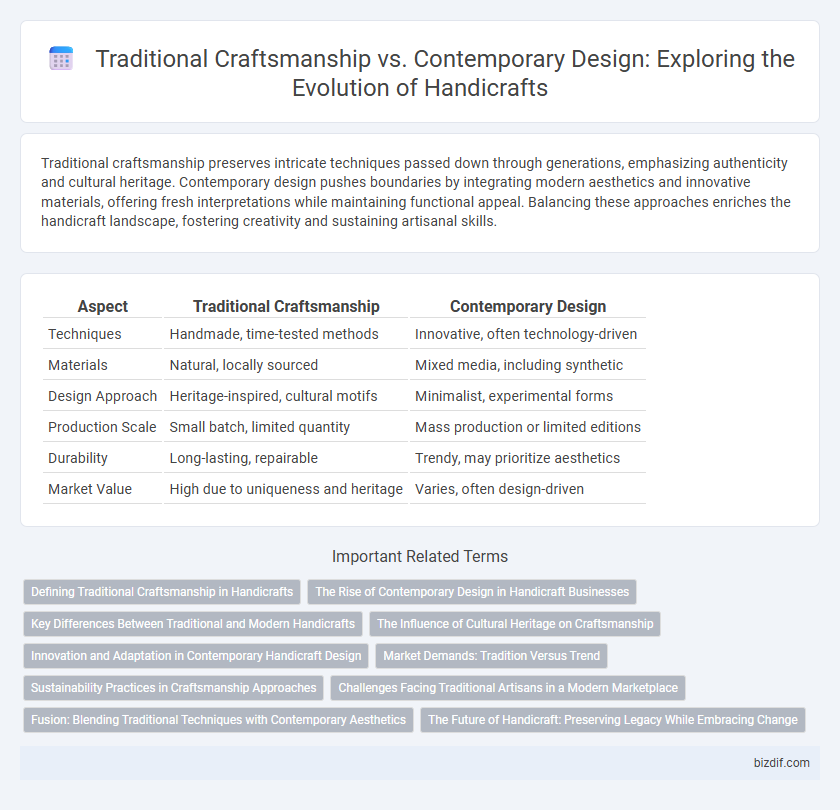Traditional craftsmanship preserves intricate techniques passed down through generations, emphasizing authenticity and cultural heritage. Contemporary design pushes boundaries by integrating modern aesthetics and innovative materials, offering fresh interpretations while maintaining functional appeal. Balancing these approaches enriches the handicraft landscape, fostering creativity and sustaining artisanal skills.
Table of Comparison
| Aspect | Traditional Craftsmanship | Contemporary Design |
|---|---|---|
| Techniques | Handmade, time-tested methods | Innovative, often technology-driven |
| Materials | Natural, locally sourced | Mixed media, including synthetic |
| Design Approach | Heritage-inspired, cultural motifs | Minimalist, experimental forms |
| Production Scale | Small batch, limited quantity | Mass production or limited editions |
| Durability | Long-lasting, repairable | Trendy, may prioritize aesthetics |
| Market Value | High due to uniqueness and heritage | Varies, often design-driven |
Defining Traditional Craftsmanship in Handicrafts
Traditional craftsmanship in handicrafts refers to the skilled techniques and methods passed down through generations, emphasizing manual dexterity and cultural heritage. It involves the use of natural materials and age-old tools to create authentic, handcrafted items reflective of specific regional or ethnic identities. This practice preserves historical artistry and maintains the intrinsic value of handmade products in a world increasingly dominated by mass production.
The Rise of Contemporary Design in Handicraft Businesses
The rise of contemporary design in handicraft businesses is transforming traditional craftsmanship by integrating modern aesthetics with artisanal techniques. This fusion attracts a broader market, enhancing the commercial appeal and sustainability of handmade products. Innovative design approaches enable craftsmen to respond to evolving consumer preferences while preserving cultural heritage through adaptive creativity.
Key Differences Between Traditional and Modern Handicrafts
Traditional craftsmanship emphasizes hand skills, cultural heritage, and time-honored techniques passed down through generations, often using natural materials and intricate detailing. Contemporary design incorporates innovative materials, technology, and minimalist aesthetics, focusing on functionality and modern appeal while sometimes blending traditional elements. The key differences lie in the production methods, design philosophy, and the balance between preserving cultural identity versus adapting to current market trends.
The Influence of Cultural Heritage on Craftsmanship
Traditional craftsmanship preserves cultural heritage through techniques and motifs passed down generations, embedding history into every handmade piece. Contemporary design often integrates these ancestral elements, reinterpreting them with modern materials and aesthetics to create innovative yet culturally resonant artifacts. The influence of cultural heritage remains a cornerstone in craftsmanship, ensuring authenticity and continuity in both traditional and contemporary creations.
Innovation and Adaptation in Contemporary Handicraft Design
Contemporary handicraft design embraces innovation by blending traditional craftsmanship techniques with modern materials and technology to create unique, functional art. Adaptation in this field involves reinterpreting cultural heritage through new shapes, patterns, and sustainable practices that appeal to current market demands. This fusion fosters a dynamic creative process, preserving artisanal skills while pushing the boundaries of design aesthetics.
Market Demands: Tradition Versus Trend
Traditional craftsmanship emphasizes time-honored techniques and authentic materials, appealing to consumers seeking artisanal quality and cultural heritage. Contemporary design responds to market demands for innovation, functionality, and aesthetic trends, blending modern materials and avant-garde styles. Balancing tradition versus trend requires understanding consumer preferences, as niche markets prioritize craftsmanship while broader audiences favor cutting-edge design.
Sustainability Practices in Craftsmanship Approaches
Traditional craftsmanship in handicrafts emphasizes the use of natural, locally-sourced materials and age-old techniques that minimize environmental impact, fostering sustainability through resource conservation and cultural preservation. Contemporary design integrates innovative sustainable practices such as upcycling, eco-friendly materials, and energy-efficient production methods to reduce waste and carbon footprint. Both approaches contribute to sustainability by promoting durability, reducing mass production, and encouraging mindful consumption in the handicraft industry.
Challenges Facing Traditional Artisans in a Modern Marketplace
Traditional artisans face significant challenges in a modern marketplace dominated by mass production and fast fashion, which prioritize cost efficiency over quality and authenticity. Limited access to digital marketing platforms and global distribution channels hinders their ability to reach a broader audience, reducing competitive advantage. Additionally, younger generations' declining interest in learning time-intensive handicraft skills threatens the preservation of cultural heritage and craftsmanship techniques.
Fusion: Blending Traditional Techniques with Contemporary Aesthetics
Fusion in handicraft seamlessly blends time-honored traditional techniques with contemporary aesthetics, creating unique pieces that honor cultural heritage while appealing to modern tastes. Artisans integrate age-old methods such as hand-weaving, embroidery, and carving with innovative materials and minimalist designs to enhance functionality and visual appeal. This synthesis not only preserves craftsmanship skills but also drives the evolution of artistic expression in the global marketplace.
The Future of Handicraft: Preserving Legacy While Embracing Change
Traditional craftsmanship preserves cultural heritage through timeless techniques and intricate artisan skills, ensuring the legacy of handcrafted goods endures. Contemporary design introduces innovation, incorporating modern materials and sustainable practices that redefine the aesthetic and functional value of handicrafts. The future of handicraft lies in harmonizing these elements, fostering a dynamic balance between preserving historical authenticity and embracing creative evolution.
Traditional Craftsmanship vs Contemporary Design Infographic

 bizdif.com
bizdif.com